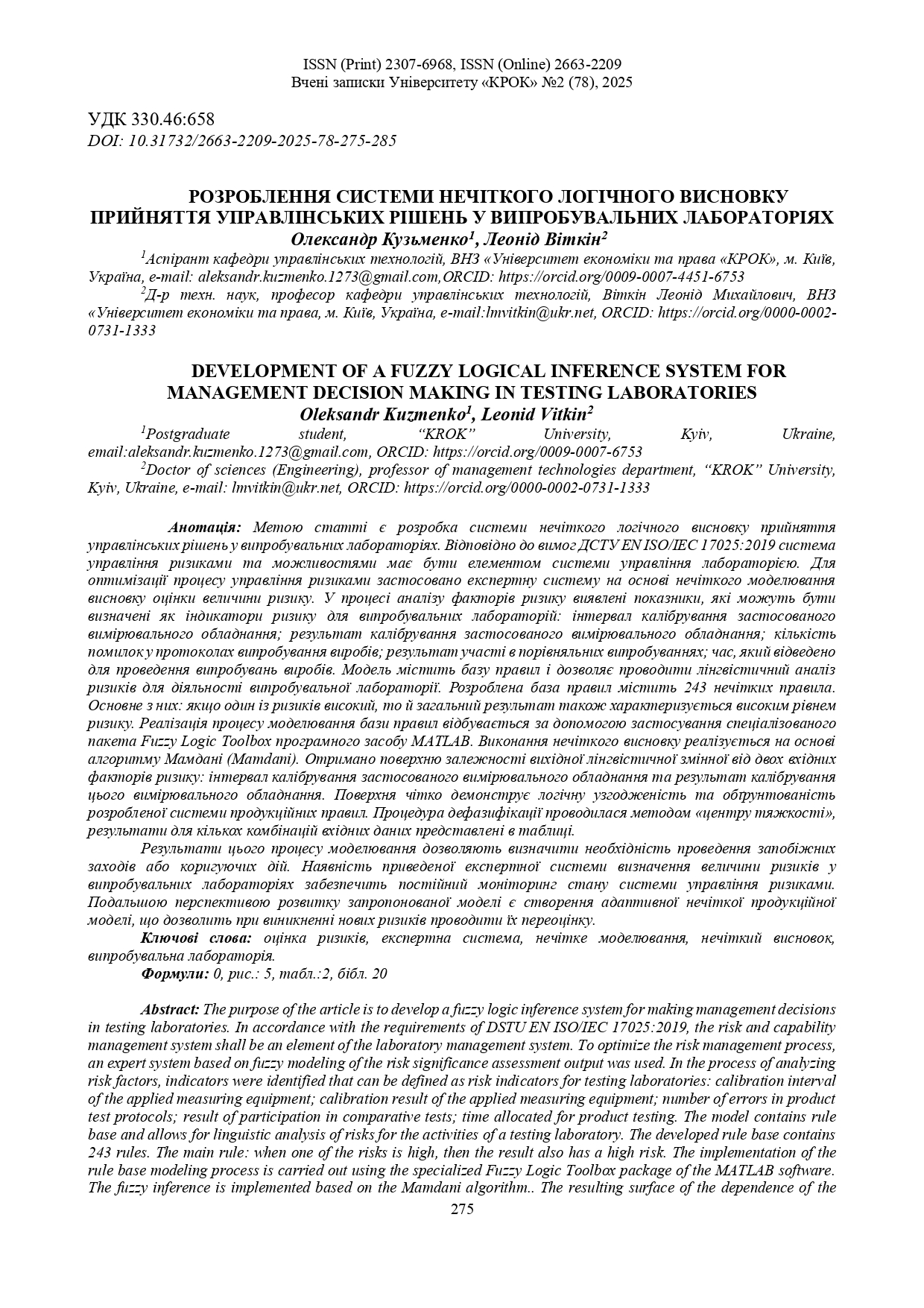DEVELOPMENT OF A FUZZY LOGICAL INFERENCE SYSTEM FOR MANAGEMENT DECISION MAKING IN TESTING LABORATORIES
DOI:
https://doi.org/10.31732/2663-2209-2025-78-275-285Keywords:
risk assessment, expert system, fuzzy modeling, fuzzy inference, testing laboratoryAbstract
The purpose of the article is to develop a fuzzy logic inference system for making management decisions in testing laboratories. In accordance with the requirements of DSTU EN ISO/IEC 17025:2019, the risk and capability management system shall be an element of the laboratory management system. To optimize the risk management process, an expert system based on fuzzy modeling of the risk significance assessment output was used. In the process of analyzing risk factors, indicators were identified that can be defined as risk indicators for testing laboratories: calibration interval of the applied measuring equipment; calibration result of the applied measuring equipment; number of errors in product test protocols; result of participation in comparative tests; time allocated for product testing. The model contains rule base and allows for linguistic analysis of risks for the activities of a testing laboratory. The developed rule base contains 243 rules. The main rule: when one of the risks is high, then the result also has a high risk. The implementation of the rule base modeling process is carried out using the specialized Fuzzy Logic Toolbox package of the MATLAB software. The fuzzy inference is implemented based on the Mamdani algorithm.. The resulting surface of the dependence of the output linguistic variable on two input risk factors: the calibration interval of the applied measuring equipment and the calibration result of this measuring equipment. The surface clearly demonstrates the validity and consistency of the developed system of production rules. The defuzzification procedure was carried out using the "center of gravity" method, the results for several combinations of input data are presented in the table.
The results of this modeling process allow determining the need for preventive measures or corrective actions. The presence of the specified expert system for determining the significance of risks in testing laboratories will ensure constant monitoring of the state of the risk management system. A further perspective for the development of the proposed model is the creation of an adaptive fuzzy production model, which will allow for their reassessment when new risks arise.
Downloads
References
Gallab, M., Bouloiz, H., Alaoui, Y., & Tkiouat, M. (2019). Risk Assessment of Maintenance
activities using Fuzzy Logic, Procedia Computer Science 148, 226-235.
https://doi.org/10.1016/j.procs.2019.01.065
Kosko, B. (1994). Fuzzy systems as universal approximates. IEE Transactions on computers, 11,
-1333. URL: https://sipi.usc.edu/~kosko/Fuzzy Universal Approx.pdf.
Mamdani, E.H. (1975). An experiment in linguistic synthesis with a fuzzy logic controller / E.H.
Mamdani & S. Assilian // International Journal of Man–Machine Studies, № 7(1), 1–13.
https://doi.org/10.1016/S0020-7373(75)80002-2
Nurutdinova, I. & Dimitrova, L. (2021). Risk significance assessment on the basis of a fuzzy
model. E3S Web of Conferences 273, 08037 (2021) INTERAGROMASH 2021, 7 p.
https://doi.org/10.1051/e3sconf/202127308037
Paluszek, M. & Thomas, S. (2020) Practical MATLAB Deep Learning: A Project-Based
Approach. 1st Ed.: Apress, 252 p. https://doi.org/10.1007/978-1-4842-5124-9
Shang, E.& Hossen, Z. (Eds.). (2013). Applying Fuzzy Logic to Risk Assessment and Decision-
Making. Casualty Actuarial Society. Canadian Institute of Actuaries. Society of Actuaries,
p. https://www.soa.org/globalassets/assets/files/research/projects/research-2013-fuzzy-
logic.pdf
Sivanandam, S.N., Sumathi, S. & Deepa, S.N. (2007). Introduction to Fuzzy Logic using
MATLAB, Springer-Verlag Berlin Heidelberg, 430 p.
http://dx.doi.org/10.1007/978-3-540-35781-0
Trpathy, S., Saxena, R. & Gupta, P. (2013). Comparison of statistical methods for outlier
detection in proficiency testing data on analysis of lead in aqueous solution. American
Journal of Theoretical and Applied Statistics. 2(6): 233-242.
http://www.sciencepublishinggroup.com/j/ajtas
Zadeh, L. (1973). Outline of a new approach to the analysis of complex systems and decision
processes / L.Zadeh // IEEE Transactions on Systems, Man, and Cybernetics, №3(1). 28–
https://doi.org/10.1109/TSMC.1973.5408575
Zadeh, L. A. (1999). Fuzzy sets as s basic for theory of possibility. and Fuzzy Sets systems,
- 34. URL: https://doi.org/10.1016/S0165-0114 (99)80004-9
Данченко, О. Б. (2014). Огляд сучасних методологій управління ризиками в проектах / О.
Б. Данченко // Управління проектами та розвиток виробництва. № 1. С. 16-25.
Доступ через: http://nbuv.gov.ua/UJRN/Uprv_2014_1_4
ДСТУ IEC/ISO 31010:2013 (IEC/ISO 31010:2009, IDT) Керування ризиком. Методи
загального оцінювання ризику. Київ. МІНЕКОНОМРОЗВИТКУ УКРАЇНИ. 2015, 73 с.
Доступ через https://khoda.gov.ua/image/catalog/files/dstu%2031010.pdf
ДСТУ EN ISO/IEC 17025:2019 (EN ISO/IEC 17025:2017, IDT) Загальні вимоги до
компетентності випробувальних та калібрувальних лабораторій. Київ. ДП
«УкрНДНЦ», 2020, 24 с. Доступ через https://uas.gov.ua.
ДСТУ ISO 31000:2018 (ISO 31000:2018, IDT) Менеджмент ризиків. Принципи та
настанови. Київ. ДП «УкрНДНЦ», 2019. 23 с. Доступ через http://uas.org.ua
Кочетков, О.В., Гаур, Т.О. & Машін, В.М. (2019). Система оцінки ризиків інформаційної
безпеки підприємства на основі нечіткої логіки. Наукові праці ОНАЗ ім. О.С. Попова,
№ 1, C. 97-104. Доступ через https://doi.org/10.33243/2518-7139-2019-1-1-97-104
Кузьменко, О.О. & Віткін, Л.М. (2024). Розроблення математичної моделі на основі
нечіткої логіки для визначення ризику в діяльності випробувальної лабораторії. Вчені
записки Університету «Крок». Розділ 2. Управління та адміністрування. Випуск №
(73). С. 188-194. DOI: 10.31732/2663-2209-2024-73-188-194
Посохов, І.М. (2013). Дослідження методів оцінки ризиків корпорацій. Європейський
вектор економічного розвитку. № 2 (15). C. 211-217. Доступ через
https://eurodev.duan.edu.ua/images/PDF/2013/2/26.pdf
Топчій, Н.В. (2020). Аналіз ризиків у випробувальній лабораторії органу оцінки
відповідності. Вчені записки ТНУ імені В.І. Вернадського. Серія: технічні науки. Том
(70). Ч. 1, № 6. С. 1-5. Доступ через: DOI https://doi.org/10.32838/TNU-2663-
/2020.6-1/01
Хавіна, І. П. & Цуранов, М.В. (2024). Дослідження механізму нечіткої логіки для оцінки
інформаційних ризиків підприємства. Харків. ХВУВС. C. 329-335. Доступ через
https://dspace.univd.edu.ua/server/api/core/bitstreams/4e9b2fa9-ead5-40c8-ba39-
c27950f8c50f/content
Штовба, С.Д. (2006). Навчання нечіткої бази знань за вибіркою нечітких даних /
Штучний інтелект. № 4. С. 560-570. Доступ через

Downloads
Published
How to Cite
Issue
Section
License

This work is licensed under a Creative Commons Attribution-NonCommercial 4.0 International License.

